Key takeaways:
- Landscape photography requires understanding light, composition, and preparation to capture stunning images.
- Challenges include unpredictable weather, managing depth of field, and the complexity of composition in vast landscapes.
- Essential equipment like a sturdy tripod and polarizing filters significantly enhances image quality and stability.
- Patience and familiarity with one’s camera are crucial for capturing the perfect shot and making the most of each location.
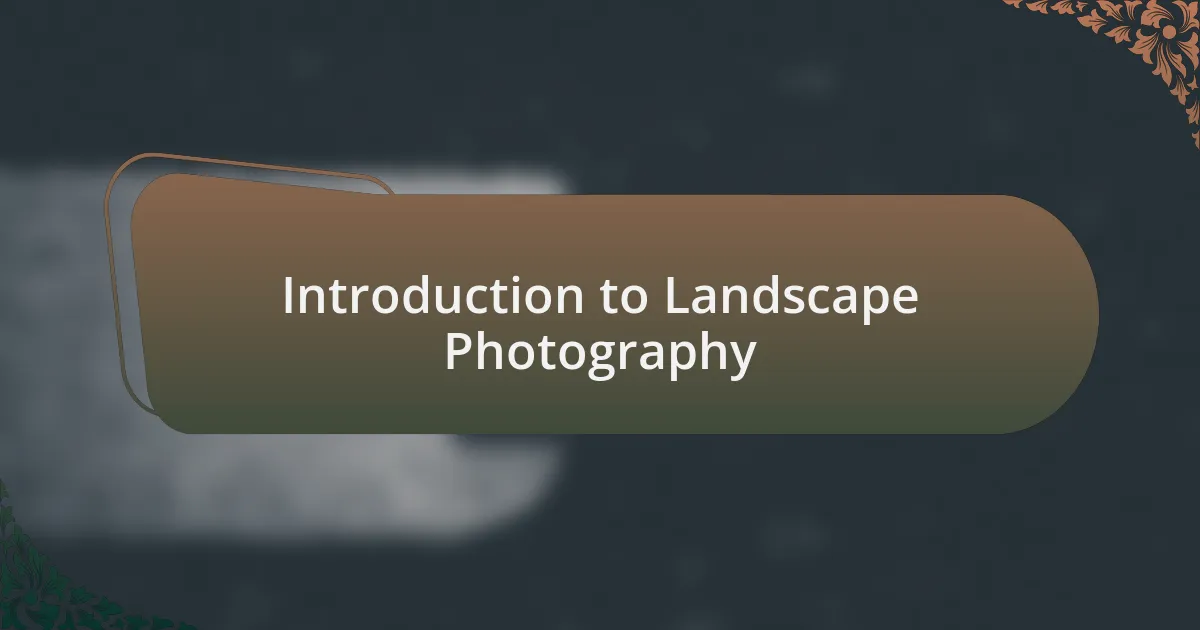
Introduction to Landscape Photography
Landscape photography is a captivating genre that invites us to explore the beauty of our natural surroundings. I still vividly remember my first hiking trip with a camera in hand; the anticipation of capturing that perfect sunset felt exhilarating. But have you ever felt overwhelmed by the sheer vastness of a landscape?
The art of landscape photography goes beyond just pointing and shooting. I often find myself pondering the power of light and composition, and how they can transform an ordinary scene into something extraordinary. For instance, I discovered that early mornings, with their soft, golden light, can make even the most familiar places look breathtakingly new. It’s these realizations that fuel my passion for this craft.
As I navigate through different terrains and weather conditions, I’ve learned that every location has its unique story to tell. The nostalgia of standing atop a mountain, with windswept hair and a camera ready, reminds me of the challenges and rewards that come with capturing nature’s grandeur. What moments have left you in awe during your own photography journey? Those are the moments that truly enrich our artistic experience in landscape photography.
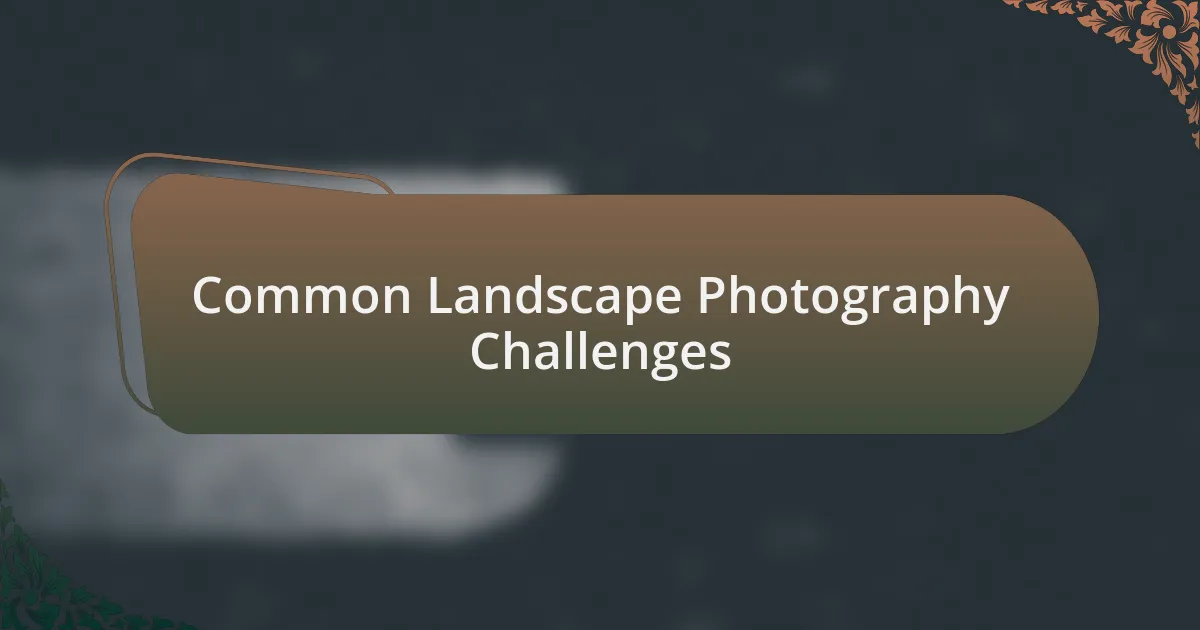
Common Landscape Photography Challenges
When I first ventured into landscape photography, I quickly encountered the challenge of unpredictable weather. I remember standing in the rain, shivering while trying to capture a moody shot of a mountain range, only to realize later that I’d forgotten to protect my gear. It’s a crucial lesson: always be prepared for changing conditions, as they can dramatically alter your composition.
Another hurdle I faced was managing depth of field. Initially, I struggled to get both the foreground and background in sharp focus. It wasn’t until I experimented with aperture settings and learned about hyperfocal distance that I felt more confident. What a difference those small adjustments can make! Have you ever had to rethink your approach to achieve the shot you envisioned?
Lastly, composition can often feel overwhelming, especially in vast landscapes where there’s so much to include. I recall a moment on the coast when I cropped the scene mentally to focus on a lone tree against the crashing waves. That decision transformed a cluttered frame into a powerful image by guiding the viewer’s eye. It’s fascinating how a shift in perspective can lead to more impactful results, isn’t it?
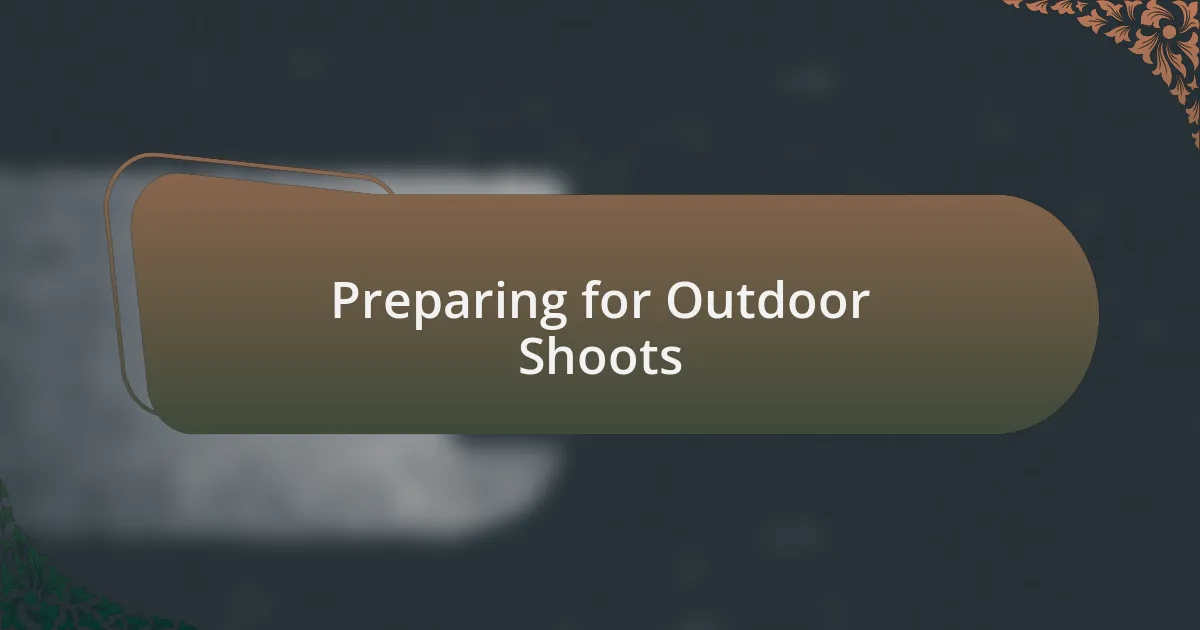
Preparing for Outdoor Shoots
When preparing for outdoor shoots, I always make a checklist to ensure I have everything I need. I recall one shoot where I forgot my tripod, which ended up being a game-changer for the stability of my shots. Have you ever realized mid-shoot that you left something crucial behind? It’s a sinking feeling, let me tell you.
Another aspect I never overlook is scouting locations beforehand. I once drove hours to a beautiful park, only to find the best vantage point was obstructed by trees. From that experience, I learned the importance of planning my route and checking satellite maps ahead of time. It might feel tedious, but trust me, it pays off when you can focus on capturing stunning images rather than searching for an ideal spot at the last minute.
Finally, consider the time of day you set out. Personally, the golden hour has become my favorite time for shooting landscapes. The warm light can transform a mundane scene into something magical. Have you ever felt the change in atmosphere as the sun begins to rise or set? I find that it adds depth and emotion to my photographs, making the effort to wake up early or stay out late well worth it.
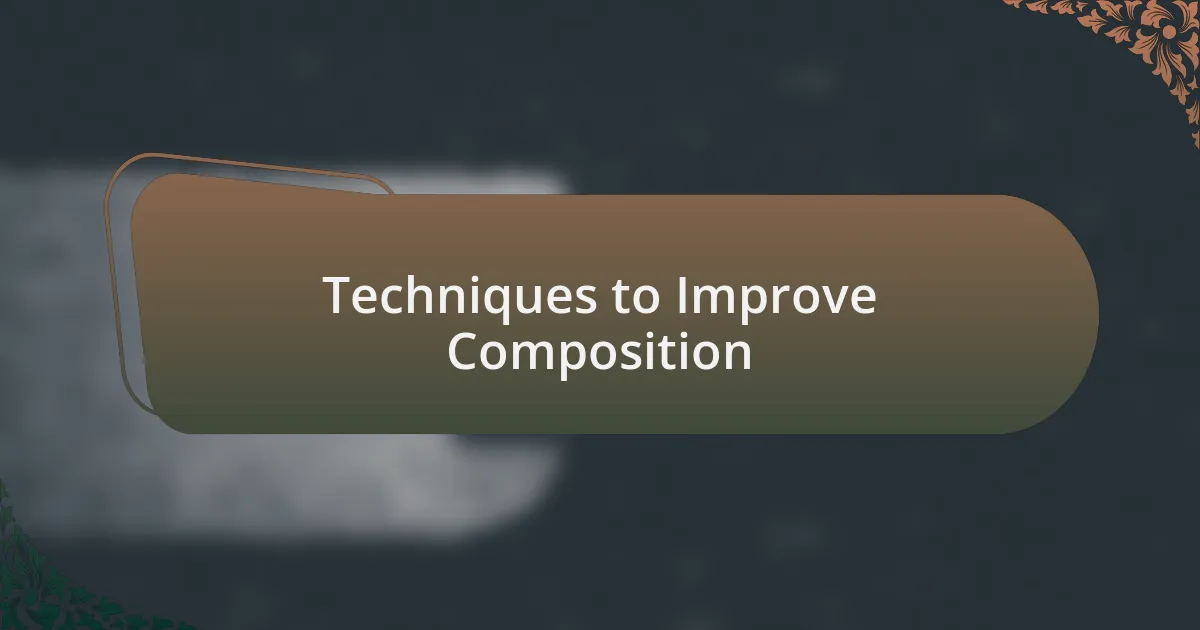
Techniques to Improve Composition
When it comes to improving composition, I’ve found that the rule of thirds is a fantastic starting point. By breaking my frame into a grid of nine equal parts and positioning key elements along those lines, I can create a more balanced and engaging image. I’ll never forget a moment when I applied this technique to a sunset shot; it elevated the entire scene, drawing the viewer’s eye naturally across the landscape. Have you ever noticed how a simple shift in placement can transform an ordinary photo into something extraordinary?
Another technique that significantly impacts my composition is leading lines. I love to incorporate natural elements like roads, rivers, or fences that draw the viewer’s gaze towards the focal point. One particular hike I took led me along a winding path flanked by wildflowers. I framed my shot so the path pulled the eye toward the mountains in the background, creating a sense of journey. Can you imagine the stories a well-composed image can tell when the viewer is guided through the scene?
Lastly, don’t underestimate the power of framing. Whenever I find a natural frame—like tree branches arching over a waterfall—I make it a point to include them in my shot. This technique adds depth and context, making the viewer feel as if they’re peeking into a world rather than just viewing a flat image. I recall one instance where I used an old stone arch as a frame for a dramatic cityscape, and it truly transformed the photograph, giving it an unexpected perspective. What compositions can you explore through framing in your own photography?

Equipment That Makes a Difference
When it comes to equipment that makes a difference in landscape photography, I can’t stress enough the impact of a sturdy tripod. Investing in a reliable tripod has changed how I approach shooting in low-light situations, especially during dawn or dusk. I remember one morning waiting for the sunrise over a misty lake; with my tripod securely holding my camera, I could use longer exposures without any shake, capturing that ethereal light that often disappears in an instant. Have you considered how much steadiness could enhance your own shots at twilight?
Another essential piece of gear is the polarizing filter. This simple yet powerful tool helps reduce glare and enhance colors, particularly in vibrant landscapes. I vividly recall a day spent in a lush, green valley after a rainstorm; by attaching my polarizer, the colors popped like I had never seen before, transforming the scene into a vivid canvas. Have you experienced the thrill of unveiling the true saturation of nature’s palette with just one small accessory?
Lastly, having a range of lenses is crucial for versatility. I often find myself switching between wide-angle for those sweeping vistas and a telephoto lens to isolate specific details in the landscape. I still think about a time when I captured a stunning mountain range, using a telephoto lens to focus on a solitary peak, which made the image feel intimate yet grand. How does your choice of lens shape the story you want to tell through your photography?
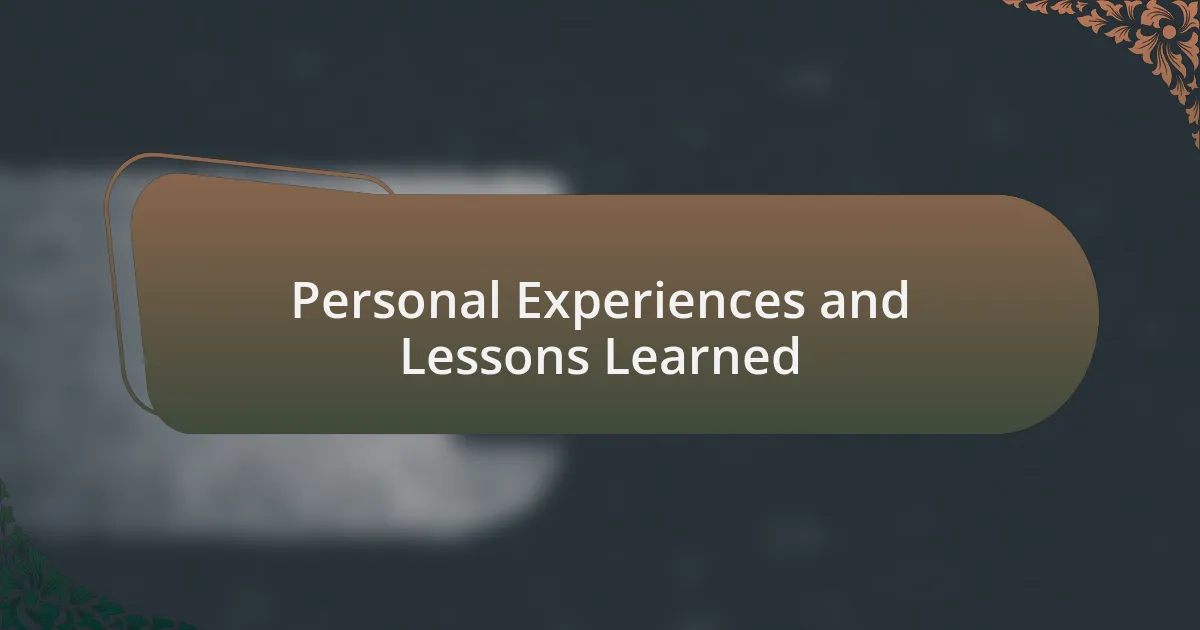
Personal Experiences and Lessons Learned
I’ve faced my fair share of challenges in landscape photography, particularly with unpredictable weather. I remember one trip to the mountains when I was met with sudden rain that threatened to ruin my plans. Instead of retreating, I embraced the storm; the clouds rolling in created dramatic lighting that added depth to my photos. Have you ever found beauty in moments when things didn’t go as planned?
Another lesson I learned was the importance of patience. I was photographing a remote coastline, and after hours of waiting for the perfect wave to crash against the rocks, I began to feel frustrated. However, when the moment finally arrived, the resulting shot was worth every second of anticipation. It taught me that sometimes the best images demand perseverance. Have you experienced that rush from waiting for the ideal shot?
I also grappled with the challenge of composition. At times, I’d be so captivated by a scene that I’d overlook how to frame it effectively. There was a particularly breathtaking sunset where I wasted precious minutes rearranging my shot, only to lose the light. That experience helped me realize that intuition often trumps indecision. How do you balance your excitement with the need for thoughtful composition in your photography?
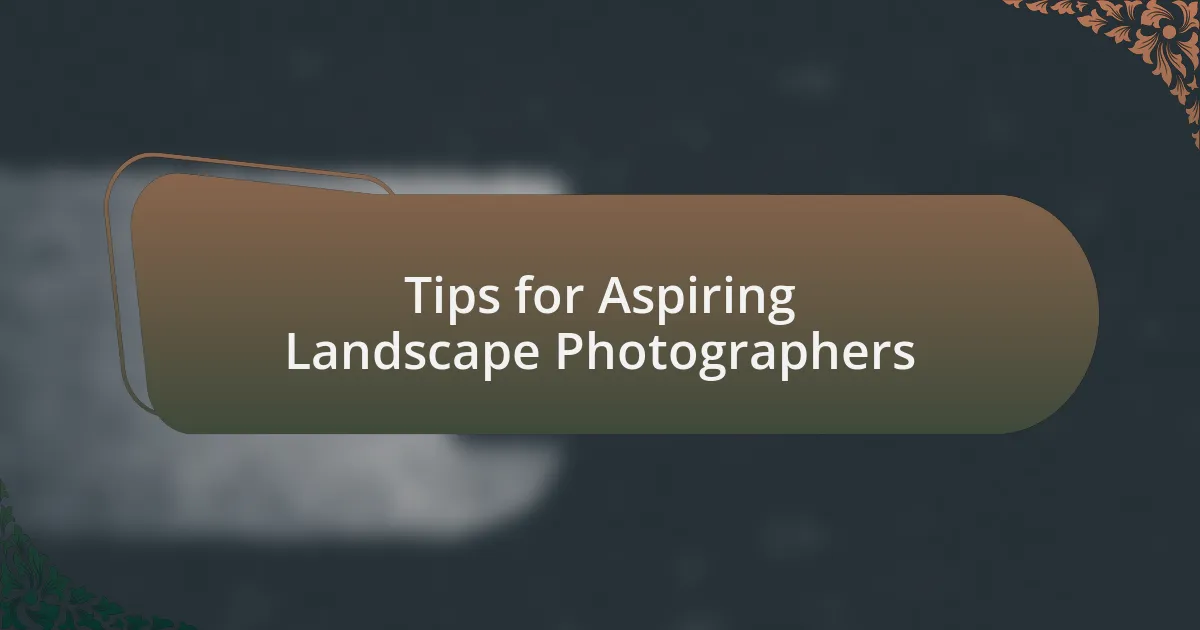
Tips for Aspiring Landscape Photographers
When venturing into landscape photography, I can’t stress enough the significance of understanding your equipment. Early on, I found myself fumbling with settings while trying to capture a stunning sunrise. It was frustrating to miss that golden moment, but it taught me that familiarity with my camera allows me to focus on the scene rather than the technicalities. What about you? Do you feel confident in adjusting your settings on the fly?
Don’t underestimate the power of scouting locations ahead of time. During one trip, I impulsively picked a spot without prior research, only to realize it lacked the perspective I was seeking. That experience reinforced my belief that knowing the lay of the land can make all the difference. Have you ever arrived at a location only to feel uninspired? A little pre-visit can ignite creative sparks.
Finally, engage with other photographers for inspiration and feedback. I remember sharing my work at a local Meetup group, and the perspectives I gained from fellow enthusiasts opened my eyes to techniques I would not have considered. Their constructive critiques helped me evolve. How often do you seek out community input in your photography journey? Regular interaction can enrich your artistic vision in unexpected ways.